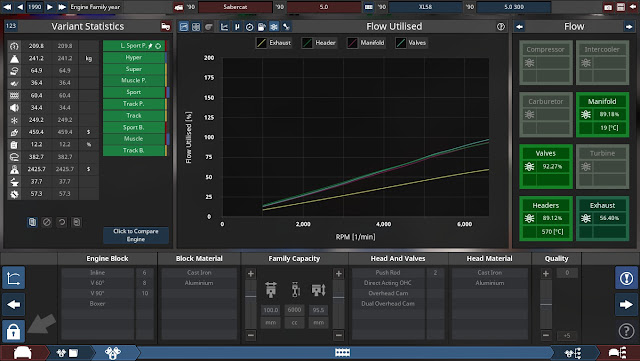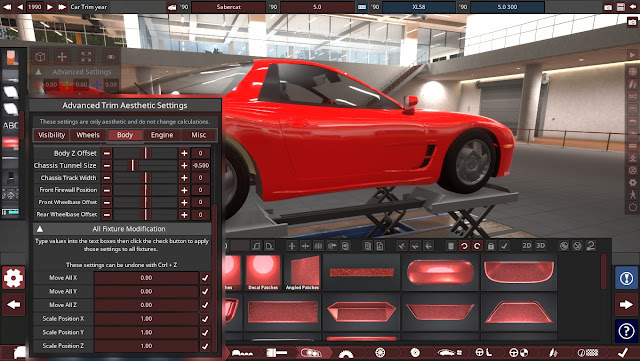Confessions of an Automationeer, Part 120: Powering Up
Now that Automation has received several very significant updates in the past few weeks, I feel like it is the right time to describe some of them in more detail. Their combined effect is that we, as players, must now rethink how we build cars and engines compared to previous builds. This has happened before in the past, but seldom on a scale as large as this. On that note, let's take a closer look.
The revised bottom end tab in the engine designer for Automation LCV 4.2.23 and up, showing the new balancing mass slider - more mass equals greater reliability and smoothness, while less mass equals less weight and better throttle response.
The first major update to Automation in some time (LCV 4.2.23) has brought with it a complete overhaul of how engines work, thereby making them more realistic than before. For starters, engine data is calculated for 1% throttle increments as well as for every 100 rpm. You can now adjust more stuff than before, such as carburetor, header and intake manifold sizes, as well as the VVL activation point on the rev range, and bottom end balancing mass weight.
The top end tab has also been revised to show RPM limit and VVL activation RPM sliders. A fueling map is also shown here.
In addition, there are some new fuel types to choose from, and there are now three cast-iron header types (compact, low and mid) instead of two. There are many other improvements as well, and the air/fuel ratio slider is now a fuel map slider, while the ignition timing is automatically adjusted (hence the absence of an adjustment slider, as had been present in previous builds).
A timing map is also new for 4.2.23 and up, while the turbocharging tab (ghosted here due to the engine shown here being normally aspirated) allows for boost adjustments in increments of 0.05 bar.
To accompany these changes, there are now additional graphs for various attributes; moreover, flow ratings are now shown as percentages of optimum air flow (the closer to 100%, the better). On top of this, the maximum RPM slider is now in the top end tab, and a whole new set of warnings have been added. Overall, designing a viable engine for any application is now more challenging, but also more rewarding than before.
Above, from top: Other new stuff introduced in LCV 4.2.23 - graphs for flow utilization, fuel efficiency and friction mean effective pressure, plus several more sliders for carburetor, intake manifold, exhaust header and exhaust pipe size. The fuel mixture slider is now a fuel map slider, while the ignition timing slider has been removed to account for the fact that ignition timing is now adjusted automatically. There is now an octane margin setting, and cast headers come in compact, low-RPM, and mid-RPM varieties, while the standard tubular headers are now referred to as Tubular Mid. Finally, there is a 4 Split Mode for viewing graphs, which shows output, timing, fuel efficiency and flow utilization graphs all at once.
The trim section of the car designer has also been revamped for the latest build. In addition to the inclusion of a selectable fuel efficiency graph (which aids in configuring gearing for economy, if you need or want it), the minimum rear braking force has been reduced further, to 20% of its maximum value. Also, throttle response now affects sportiness and wheelspin: the more responsive an engine is, the sportier it will be (and the more wheelspin it will generate).
The transmission tab has been updated for LCV 4.2.23, and shows an option for a clutched LSD - less effective than a geared equivalent, but available sooner. A fuel efficiency map is also shown here.
Furthermore, the fixture tab now has a new set of buttons and commands (such as clone in place and flip with mirroring), while fixtures, paints, advanced trim settings and morphs can now be copied through the clipboard and even other cars. Speaking of advanced trim settings, they now include tire shine and tread depth settings, both of which can be adjusted through sliders. In addition, all calculations have been reworked in this new build, and some new bodies have been added in addition to, or in place of, existing ones that have been present for quite some time.
Additional options (such as cloning in place and flipping to the opposite side) have been added to the fixture manipulation section of the fixtures tab.
After the release of LCV 4.2.26, engines are now even more realistically depicted than before. For example, direct injection has been nerfed slightly, minimum boost is now 0.05 Bar (with boost now being adjustable in increments of 0.05 Bar) while standard manifolds have had their airflow buffed, and all mufflers and catalytic converters now have backpressure effects, with torque outputs being increased slightly across the board to account for this. In addition, advanced automatic transmissions can have up to 10 gears (depending on the era), while dual-clutch transmissions can also have more gears. As for suspension tuning, the maximum value for springs and dampers is now 20 instead of 10.
The most significant change stemming from this update is the addition of a new feature to the sandbox: the tech pool. It is meant to simulate the amount of R&D a manufacturer has undertaken, often for the purpose of reflecting the company's lore. This reduces production units and engineering time for a specific component, but more importantly, unlocks certain parts sooner by shifting the year for that part forward by a set number of years.
Introduced in LCV 4.2.26, the Tech Pool is a new feature that allows you to unlock some parts sooner - you can even copy and paste tech pool values between trims. By default, each part has a tech pool value of 5, although you can change this as you see fit.
With this in mind, you can also copy tech pool settings to the clipboard for future use, and paste them if you want to reuse them on another car trim or engine variant as you see fit. Before this update, all components were treated as having a tech pool value of 0 outside of the campaign mode; now, however, the default tech pool value has been set to 5 for all components. However, some forum challenges require a tech pool value of 0 across the board, in a nod to earlier versions.
The next update, LCV 4.2.27, brings with it even more changes to trim options and availability. For one, manual and (non-variable) hydraulic steering options have been split into two types each: recirculating ball and rack and pinion, with the latter providing better stats at the expense of generally higher cost. In addition to this, a clutch-based limited-slip differential is now available. The clutched LSD (as the game puts it) is more primitive than a geared equivalent, but is unlocked earlier. This avoids having to substitute an automatic locking differential (normally best suited for off-road applications) for a true geared LSD in earlier years (pre-1982 if the drivetrain tech pool is set to 0). Moreover, a clutched LSD is generally cheaper to develop than a geared one, and provides better off-road capabilities at the expense of inferior drivability.
LCV 4.2.27 introduced options for recirculating ball or rack and pinion steering for manual (i.e. unassisted) and regular hydraulic (i.e. non-variable) steering systems.
From version 4.2.28 onwards, there is now an advanced trim setting that allows you to move and scale every fixture on a given trim at once, and copy them to another, different trim - far faster than having to duplicate each fixture separately from scratch.
Above, from top: It is now possible to scale and move every fixture at once, as well as copy and paste fixtures, materials, advanced trim settings, and morphs from the advanced trim settings menu.
In addition to these updates, the developers have also released some minor patches to fix any bugs present. The effect of these is to provide a more stable and cohesive experience overall. When combined with the various major updates described above, building a car (and its engine) in Automation is now a generally more enjoyable experience - and this will be even more true once the current open beta build becomes stable enough to become the latest public release.
Update (12:00 am, UTC +7): LCV 4.2.30 introduces AFR (air/fuel ratio) dependent combustion chamber cooling effects, reducing the probability of knocking. In addition, carburetor flow and manifold/header resonance curves have been adjusted slightly to account for this, and there are several minor bug fixes as well.













No comments:
Post a Comment